Possible Acquisition and Molecular Evolution of vpu Genes Inferred from Comprehensive Sequence Analysis of Human and Simian Immunodeficiency Viruses
- PMID: 40544231
- PMCID: PMC12354576
- DOI: 10.1007/s00239-025-10256-6
Possible Acquisition and Molecular Evolution of vpu Genes Inferred from Comprehensive Sequence Analysis of Human and Simian Immunodeficiency Viruses
Abstract
Vpu, an accessory protein of human immunodeficiency virus-1 (HIV-1), plays a crucial role in viral particle production and significantly contributes to HIV virulence. However, the evolution of the vpu gene remains poorly understood. We conducted a computational analysis of approximately 39,000 simian immunodeficiency virus (SIV) and HIV sequences, focusing on 141 representative Vpu proteins. Phylogenetic analysis classified the SIV and HIV strains into four major types based on their Vpu proteins: Vpu-type 1 (ancestral, found in SIVs such as SIVmon and SIVgsn), Vpu-type 2 (SIVgor and HIV-1 group O), Vpu-type 3 (SIVcpz), and Vpu-type 4 (HIV-1 group M and N). Notably, Vpu-type 1 exhibited variability in gene length, genome length, and the overlap between vpu and env compared with other Vpu-types. A phylogenetic tree was constructed using 426 nucleotide sequences from HIV-1, HIV-2, and SIVs focusing on the region between the pol and env genes. Vpu-type 1 was closely clustered with SIVasc and SIVsyk, lacking both vpu and vpx. The similarities observed between vpu and genes such as vpr and env suggest that vpu originated within the SIV genome. In addition, a phylogenetic tree constructed from 252 Vpu-type 4a sequences from the HIV pandemic strain and 135 sequences of circulating recombinant forms of HIV-1 revealed 18 distinct protein subtypes, exceeding the number of previously recognized subtypes. The systematic analysis of the sequences from large datasets has enabled a detailed characterization of the transition states of vpu, enhancing our understanding of the processes driving viral diversity.
Keywords: Bioinformatics; HIV-1; Molecular evolution; Phylogenetic tree; SIV; Vpu.
© 2025. The Author(s).
Conflict of interest statement
Declarations. Conflict of Interest: The authors declare that they have no conflicts of interest.
Figures
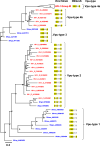
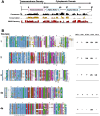
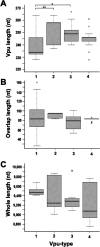
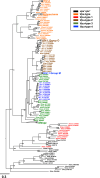

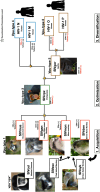
Similar articles
-
Vpu of a Simian Immunodeficiency Virus Isolated from Greater Spot-Nosed Monkey Antagonizes Human BST-2 via Two AxxxxxxxW Motifs.J Virol. 2020 Jan 6;94(2):e01669-19. doi: 10.1128/JVI.01669-19. Print 2020 Jan 6. J Virol. 2020. PMID: 31666374 Free PMC article.
-
Characterization of a novel simian immunodeficiency virus with a vpu gene from greater spot-nosed monkeys (Cercopithecus nictitans) provides new insights into simian/human immunodeficiency virus phylogeny.J Virol. 2002 Aug;76(16):8298-309. doi: 10.1128/jvi.76.16.8298-8309.2002. J Virol. 2002. PMID: 12134035 Free PMC article.
-
Characterization of a novel simian immunodeficiency virus (SIVmonNG1) genome sequence from a mona monkey (Cercopithecus mona).J Virol. 2003 Jun;77(12):6879-88. doi: 10.1128/jvi.77.12.6879-6888.2003. J Virol. 2003. PMID: 12768007 Free PMC article.
-
Role of Viral Protein U (Vpu) in HIV-1 Infection and Pathogenesis.Viruses. 2021 Jul 27;13(8):1466. doi: 10.3390/v13081466. Viruses. 2021. PMID: 34452331 Free PMC article. Review.
-
Male circumcision for prevention of heterosexual acquisition of HIV in men.Cochrane Database Syst Rev. 2003;(3):CD003362. doi: 10.1002/14651858.CD003362. Cochrane Database Syst Rev. 2003. Update in: Cochrane Database Syst Rev. 2009 Apr 15;(2):CD003362. doi: 10.1002/14651858.CD003362.pub2. PMID: 12917962 Updated.
References
-
- Bailes E, Gao F, Bibollet-Ruche F et al (2003) Hybrid origin of SIV in chimpanzees. Science 300:1713. 10.1126/science.1080657 - PubMed
-
- Bbosa N, Kaleebu P, Ssemwanga D (2019) HIV subtype diversity worldwide. Curr Opin HIV AIDS 14:153–160. 10.1097/COH.0000000000000534 - PubMed
-
- Bi X, Liu LF (1996) A replicational model for DNA recombination between direct repeats. J Mol Biol 256:849–858. 10.1006/jmbi.1996.0131 - PubMed
MeSH terms
Substances
LinkOut - more resources
Full Text Sources

